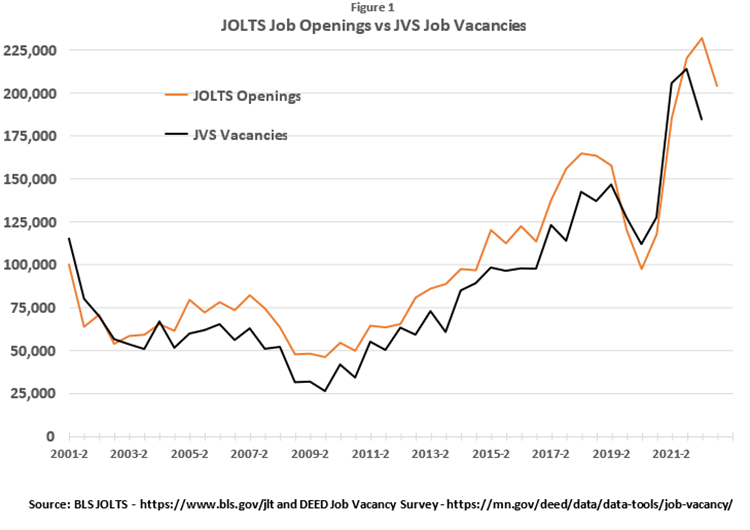
by Dave Senf
June 2023
During the current era of worker shortages and resulting tight labor market conditions here in Minnesota and around the country, labor market analysts, journalists, employers and others are paying extra close attention to tools that monitor job demand. Since the fall of 2021, the U.S. Bureau of Labor Statistics (BLS) has published state-level Job Openings and Labor Turnover Survey (JOLTS) data.; Minnesota was way ahead of the BLS with its initial release of the Minnesota Job Vacancy Survey (JVS) two decades ago. Some other states have published or are publishing similar types of surveys, but Minnesota's job vacancy survey is the longest running. This article offers a quick overview of how JVS and JOLTS are alike and how they differ.
Minnesota's JVS provided job vacancy estimates for the first time in the second quarter of 2001.1 JVS continued to be conducted via a biannual survey of employers during the second and fourth quarters until 2022 when it became an annual survey. JVS provides estimates for the six state planning regions as well as statewide, plus detailed vacancy information for 20 industries and 22 occupational groups, as well as more than 500 occupations. JVS provides information on wages and benefits, education, training and experience requirements for open positions, and location of openings. JVS data also contain information about company size (as measured by number of employees) and whether vacancies are full-time or part-time and temporary or seasonal. The JVS estimates are collected through a survey of a stratified sample of about 6,500 firms.
On the other hand, JOLTS state-level data is released monthly, shortly after the U.S. data, and it provides information on quits, layoffs, and total separations, which JVS does not provide. The only measure that JOLTS and JVS have in common is the job openings (job vacancy) estimate. Annual JVS data provides more in-depth information to job seekers as well as job counselors in Minnesota. JVS information helps employment, training and education providers understand current labor market conditions in their region and tailor services to better meet customer and employer needs. JOLTS data at the national and state level provide aggregated measures that are helpful in evaluating labor market trends over time.
So how well do JOLTS job openings estimates for Minnesota align with JVS numbers over the past two decades? Remarkably well with similar turning points. The R² value for the two series is 0.92, which translates into a high degree of correlation between JOLTS job openings and JVS job vacancies. This can be seen in Figure 1 below. JOLTS job opening estimates have tended to run a bit higher than job vacancy estimates overall, but both the series appear to give a reliable estimate of labor demand. Both series have showed a decline in vacancies recently after reaching record-highs a year ago.

View a Tableau visualization of JOLTS monthly data for all states and the U.S. Data can be downloaded from the visualization and multiple views comparing JOLTS data across states and through time are displayed, allowing quick analysis of relative labor demand among the states.
1Minnesota Job Vacancy Survey results since 2001 are available. A short writeup accompanies each JVS release providing a brief summary of the latest estimates.